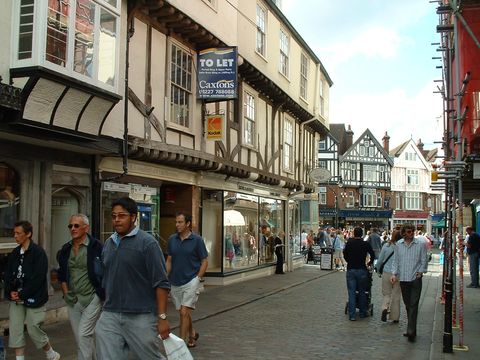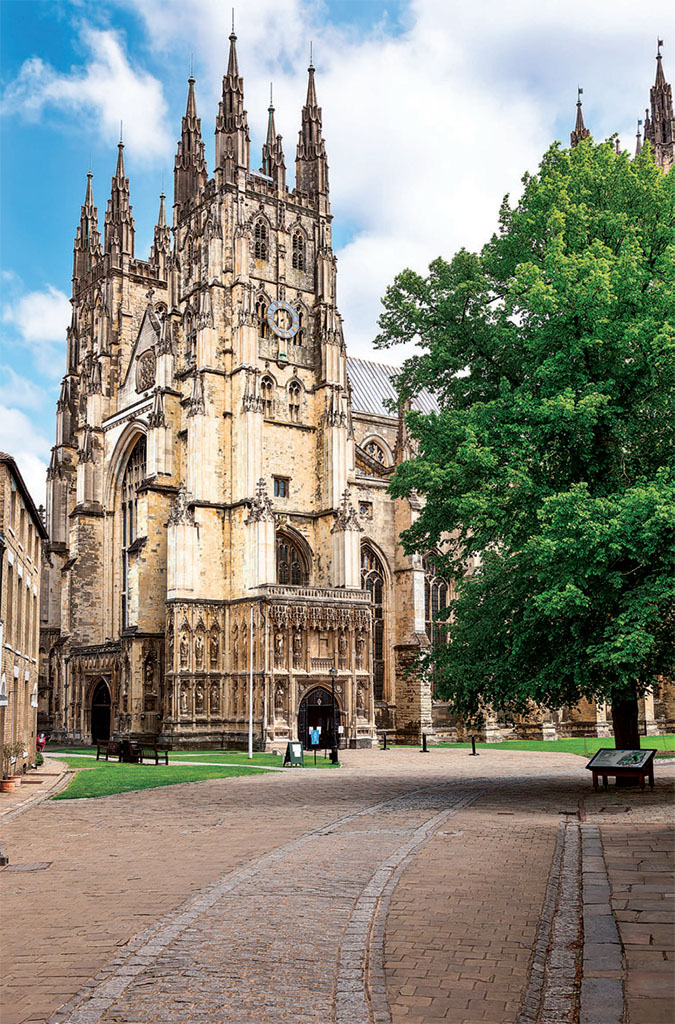
Cantebury center.Andy Roberts / Flickr
A roundup of what to do, where to go, and what you have to see in Canterbury.
For a small city (population 55,000), Canterbury hosts an amazing wealth of history -architectural, ecclesiastical, and literary. Whether as a day excursion from London or part of a road trip through the Garden of England, Canterbury is a city that richly repays the visit of a day or two. Frequent train service to Canterbury can be had from London Victoria, St. Pancras, or Charing Cross stations. It's a journey of an hour and a half.
By road, follow the track of Chaucer's pilgrims from London on the A2 - a slower, but more interesting ride than the M2. You might stop off in Rochester or Cobham to explore Dickens's connections along the way. Faversham is another gorgeous, interesting market town right on the route.
A Canterbury arrival
As always, the Visitor Information Centre on the High Street is a good place to start. Apart from maps and brochures, from there join 90-minute guided walking (or river) tours. The official tourism website offers comprehensive information on events, attractions, and accommodation options.
If your visit is more than a day trip, the Falstaff Hotel on St. Dunstans Street is a centrally located classic 15th-century coaching inn. Or stay in the cathedral close itself at the Canterbury Cathedral Lodge. ABode Canterbury offers 4-star accommodation and amenities in a perfect center city location.

11th-century Canterbury Cathedral draws pilgrims from around the world today as it did in Chaucer's time.Image: DMITRY NAUMOV
Seeing the old city
Mother Church of the worldwide Anglican Communion and seat of the Archbishop of Canterbury, Canterbury Cathedral understandably dominates the city center. Built in the late 11th century with Caen stone from Normandy, the soaring architecture exudes the air from centuries of worship.
While it receives more than a million visitors a year, beat the crowds by attending choral evensong weeknights at 5:30pmm, and hear the crystal-clear voices of its amazing choir echoing through the reaches of Bell Harry Tower. The precincts outside the cathedral gates are pedestrianized, full of shops, cafes, narrow cobbled streets, and crowds.
It was to Canterbury that St. Augustine brought Christianity to southern England in 597. The ruins of the abbey he established, rebuilt in 978 following Viking raids, stand today on Longport, though its cloister and church were destroyed in the 16th-century Dissolution of the Monasteries. St. Augustine also founded a school that became The King's School, the oldest in the country. Charles Dickens's David Copperfield attended.
Among the most famous events in the city's long ecclesiastical history was the murder of Archbishop Thomas Becket on Christmas 1170. The story is tellingly written in T.S. Eliot's verse play Murder in the Cathedral. Becket's shrine near the cathedral altar became the most important site of pilgrimage in England, and 200 years later, of course, was the objective of Chaucer's celebrated tale-telling pilgrims. The site of the medieval shrine and Becket's murder is suitably commemorated in the cathedral's west transept. Together with the Saxon church of St. Martin (oldest active parish church in England), the cathedral and abbey are recognized by UNESCO as a World Heritage Site.
The Eastbridge Hospital of St. Thomas, founded in 1180, was a hostelry for visiting pilgrims to Becket's shrine. Its crypt, chapel and refectory still stand, open to the public. While traces of Canterbury's ancient walls surround the city, its most dramatic remainder is Westgate. Built in 1380, Westgate Tower is the largest and oldest surviving medieval gatehouse in England. Today it houses a museum of its long history, including many years as a jail. From the battlements, you will find the best vantage point in the city for pictures of the entire cathedral and the cityscape below.
To step back into the 14th-century city, you might visit Canterbury Tales on St. Margaret's Street. Certainly an attraction rather than a museum, but it does bring to life the stories and times of Chaucer's pilgrims.
Like most places in this part of the country close to where they landed, however, the Romans were here a millennium before the observable medieval city. Vestiges of Roman occupation remain, most prominently at Canterbury's Roman Museum, built around the remains of a Roman townhouse and containing well-preserved mosaics.
After hours in town
Accessible at several points in the center, punting on the River Stour is a popular pastime - and offers a different perspective on the city entirely.
As a university town and tourist hot spot, pubs, restaurants and gathering points abound. The Thomas Ingoldsby and The West Gate Inn offer reliable Wetherspoons hospitality and a full food menu until 11 p.m.
The Marlowe Theatre, named after Elizabethan playwright and native son Christopher Marlowe, is one of the Southeast's principal venues for top-quality plays and concerts. There is virtually always something playing!
In the neighborhood
By rail or road, a return to the M25 is quick. Canterbury also makes an easy base from which to explore Margate, Broadstairs and the Isle of Thanet or the famed White Cliffs of Dover. To the southwest lie Folkestone and the hop fields and orchards of Kent.
Read more
* Originally published in April 2018.





Comments